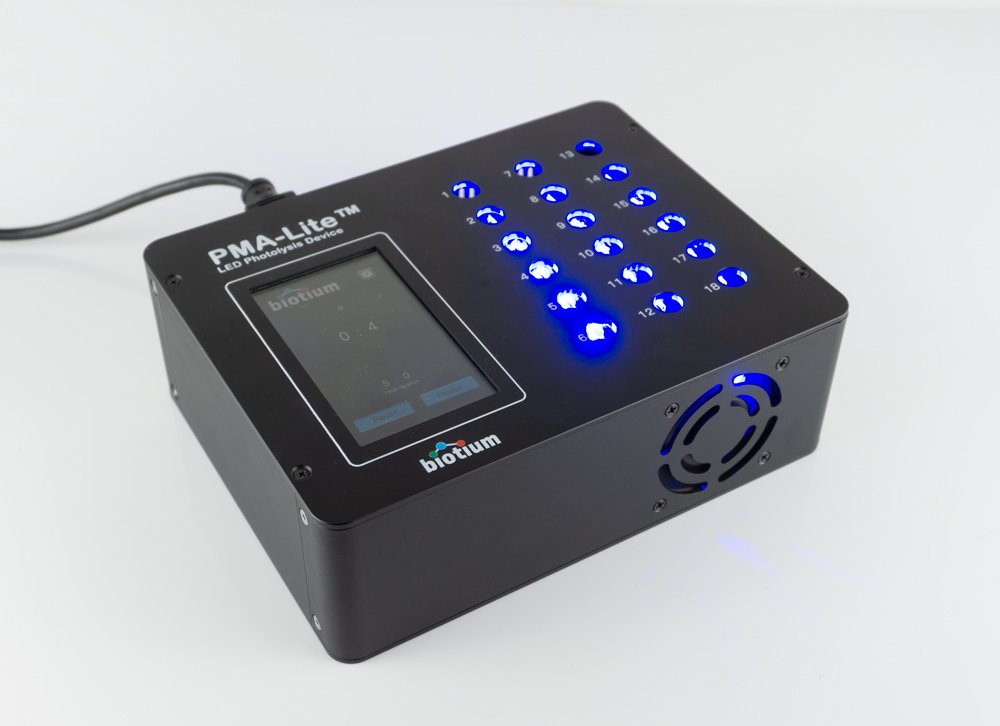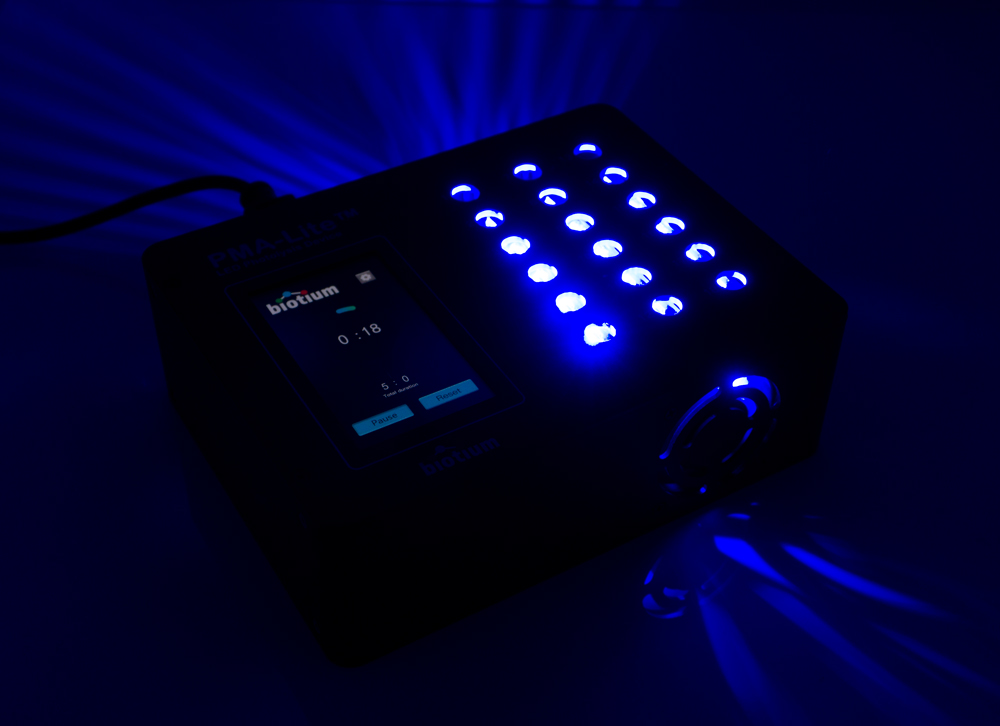Specifications:
| Application | qPCR | Warranty | 1 Year |
| Storage Temperature | Ambient | ||
| Product Type | Molecular Biology Equipment | ||
| Product Brand | Biotium | ||
| Product Grade | Molecular Biology | ||
The PMA-Lite™ 2.0 LED Photolysis Device is a compact, high-efficiency LED light box engineered by Biotium for the selective photoactivation of viability PCR (v-PCR) dyes such as Propidium Monoazide (PMA), PMAxx™, and Ethidium Monoazide (EMA). Designed for ease of use and consistent results, this device delivers uniform illumination across up to 18 microcentrifuge tubes, enabling precise, reproducible differentiation of live and dead cells in microbial populations.
It offers programmable photoactivation, real-time monitoring via touch screen interface, and an integrated cooling fan to maintain sample integrity—all within a lightweight, bench-top footprint. PMA-Lite™ 2.0 provides an ideal solution for labs performing microbial viability testing in clinical, food safety, water testing, and environmental microbiology applications.
Key Features
- Uniform, High-Intensity LED Illumination: Emits visible light in the 465–475 nm range, optimized for activation of PMA, PMAxx™, and EMA dyes, ensuring complete and even photolysis across 18 tubes simultaneously.
- Temperature Regulation: Equipped with an internal fan to maintain a temperature below 37 °C, protecting temperature-sensitive DNA and sample components.
- Programmable Timer: Touch screen interface allows precise setting of photoactivation durations between 5 and 45 minutes.
- Broad Voltage Compatibility: Operates within a global voltage range of 100–240 VAC at 50–60 Hz; includes a universal outlet adapter for international use.
- Compact and Lightweight: Designed for benchtop workflows with small footprint and low weight (1.85 kg).
- Enhanced Usability: Upgraded from the original PMA-Lite™ with an intuitive touch screen and improved control features.
- Two-Year Warranty: Reliable performance backed by a 2-year manufacturer’s warranty from Biotium.
Technical Specifications
| Parameter | Value |
|---|---|
| Dimensions (W × D × H) | 22 × 17 × 8.3 cm (8.66 × 6.69 × 3.27 in) |
| Weight | 1.85 kg (4.1 lbs / 65.3 oz) |
| Power Input | 100–240 VAC |
| Frequency Range | 50–60 Hz |
| Maximum Power Consumption | 60 W |
| LED Output Wavelength | 465–475 nm |
| Tube Capacity | 18 microcentrifuge tubes |
| Photoactivation Timer Range | 5–45 minutes |
| Temperature Control | ≤ 37 °C (via internal fan) |
Applications
-
Viability PCR (v-PCR) using PMA, PMAxx™, or EMA dyes for:
- Live/dead discrimination of bacteria, fungi, and viruses
- Detection of viable but non-culturable (VBNC) organisms
- Microbial viability assessment in complex or mixed-strain samples
- Rapid pathogen detection in food, water, and environmental samples
- Monitoring microbial reduction efficacy in clinical settings
- Real-time PCR (qPCR), LAMP, and other amplification assays
How It Works
In v-PCR, samples are treated with membrane-impermeant, photoreactive DNA dyes like PMA or PMAxx™, which selectively penetrate and bind to DNA in dead cells. When exposed to visible light, the dyes crosslink covalently to the DNA, making it unavailable for amplification. The PMA-Lite™ 2.0 ensures uniform, high-intensity illumination across all tubes, maximizing dye activation while preserving sample temperature. This results in clear differentiation between viable and non-viable cells during downstream PCR analysis.
Workflow Compatibility
Use the PMA-Lite™ 2.0 in combination with:
- Biotium PMA or PMAxx™ dyes
- Standard microcentrifuge tubes
- qPCR thermocyclers or LAMP instruments
- DNA extraction kits and PCR cleanup protocols
The PMA-Lite™ 2.0 LED Photolysis Device is a vital accessory for any laboratory implementing viability PCR workflows. With precise light control, broad sample capacity, and temperature stability, it ensures reliable activation of PMA-based dyes for accurate microbial viability assessment. Whether you're testing clinical samples, monitoring water quality, or verifying food safety, PMA-Lite™ 2.0 offers the performance and convenience required for modern molecular diagnostics.




 0
0



